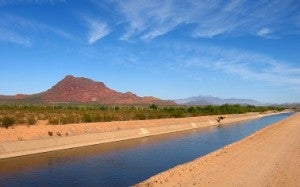3 investment ideas to sustain water in the American West

The crippling drought in the American West is now making headlines daily and the stories are raising a collective awareness of the unfolding crisis – as The New Yorker did recently when it chronicled the plight of the Colorado in Where the River Runs Dry.
If there’s a silver lining to the Western water crisis, it’s that governors, state legislators and federal policymakers are finally taking action to ensure a reliable water supply.
These are welcome actions – except, top-down government mandates, while sometimes necessary, won’t result in the durable change we need to move from scarcity to sustainability.
Top-down mandates only work as long as there is political will to enforce them. In order to crack open the ossified structure that has dictated unsustainable water policy for more than a century, we need to build ground-level support for flexible solutions that benefit everyone – including cities, agriculture and, of course, the environment.
Here are three areas that are ripe for investment:
1. Groundwater allocation: Local solutions key
Groundwater is vital for irrigation, drinking water and freshwater ecosystems. In California, we have a golden opportunity to get groundwater management right on all counts.
Until last September, California groundwater was unregulated. Today, there is a new law on the books that requires local districts to develop plans for maintaining safe levels in their aquifers.
Early success in influential communities can build the champions and examples needed to create change now, spur additional water reform in California, and help inform groundwater initiatives elsewhere in the West.
Now is the time for agricultural, business, environmental and local community interests in these groundwater basins to come together to design and implement incentive and market-based approaches to groundwater management.
For example, by implementing tiered pricing for groundwater use such as what we’ve seen in Orange County, incentives can help manage extractions. It’s possible for some portion of the revenue to be dedicated to multi-benefit groundwater recharge projects to improve both water supply reliability and aquatic habitat.
2. Water transactions: Flexible rules can benefit people, environment
Regulations in California and throughout the West allow limited use of water trading to move water. As water managers face potential shortfalls, they are turning to these mechanisms to avoid cut backs on those who can tolerate it least by compensating willing sellers for water.
But the process is slow and clunky.
Now is the time for agriculture, industry, agencies, NGOs and academia to help design more flexible rules governing transactions with conditions that protect not only water supply reliability for farms and cities, but also rural communities and the environment.
3. Supply chains: Consumer and companies can add pressure
We’ve seen how consumers and corporations can drive sustainability through the supply chain. It was consumer pressure, for example, that forced tuna fisherman in the 1990s to adopt dolphin-safe practices.
Today, consumer pressure is accelerating demand for zero-deforestation palm oil. And companies such as Walmart, Campbell’s Soup and United Suppliers are increasing demand for nutrient-efficient grains as part of an initiative to reduce their greenhouse gas footprint.
An unmistakable shift in these conversations today is the priority being placed on decreasing the risk of supply and price vulnerability associated with water scarcity.
Now is the time for companies to develop lasting sustainability commitments, and to take advantage of evolving metrics that can help them track success.
A rare opportunity
The pressure of overuse and drought makes this one of the most potentially productive periods in generations to cut the Gordian Knot of Western water.
Government can do its share. But the real solutions need to bubble up from the ground. Let’s tap into them.












